|
27 km north of Damascus; Seidnaya is more notable as a place of religious pilgrimage than for any outstanding remains. In fact, few reminders of its origins can be distilled from centuries of legends.
The Lady Virgin Monastery
The chapel and convent is perched on an outcrop of rock. The monastery was founded in 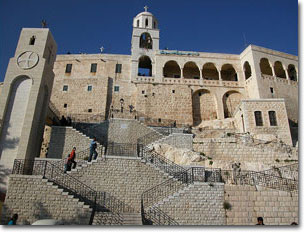 547 AD. According to legend, the Virgin Mary appeared to Emperor Justinian first as a beautiful gazelle and then as an icon; she then asked him to found the monastery in her honor, even providing the plan of the building. The miracles associated with the image of the Virgin brought the chapel wide fame particularly during and after the middle age. It became the most famous center for pilgrimage in the east, after Jerusalem. Even in times of open hostility between the Franks in Jerusalem and the Muslims of Damascus, Christian pilgrims reached Seidnaya. 547 AD. According to legend, the Virgin Mary appeared to Emperor Justinian first as a beautiful gazelle and then as an icon; she then asked him to found the monastery in her honor, even providing the plan of the building. The miracles associated with the image of the Virgin brought the chapel wide fame particularly during and after the middle age. It became the most famous center for pilgrimage in the east, after Jerusalem. Even in times of open hostility between the Franks in Jerusalem and the Muslims of Damascus, Christian pilgrims reached Seidnaya.
The convent's revered icon of the Theotokos ("the God Bearer" referring to the Virgin) was procured under equally miraculous circumstances in the 8th century. The story begins with a monk named Theodore, who stayed over at the Seidnaya convent on his way to the Holy Land. The abbess, Marina, asked him to buy an icon of the Holy Virgin for the convent while he was there. Theodore did so (after being reminded by a mysterious voice) and his return journey was marked by many miraculous escapes from danger. Theodore was so taken by the icon and its miraculous powers that he became tempted to keep it for himself. He tried to bypass Seidnaya and sail for Egypt, but a great storm arose and the ship nearly sank. Back on shore, he went to the convent but told Marina he had been unable to buy an icon and planned again to keep it for himself. But as he tried to leave the monastery, an invisible wall blocked him and he could not pass. He finally handed over the icon to Marina and confessed his intentions.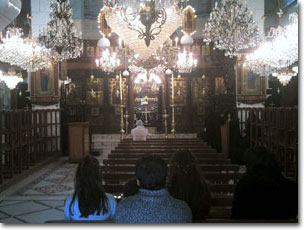
After entering through a maze of passages you finally reach the Chapel of the Virgin where you must remove your shoes. The walls are covered with beautiful icons, but the focus is the miraculous icon of the Virgin brought by the monk Theodore.
The Crusaders were fascinated by the legends of whom they called "Notre Dame de Sardeneye" associated with a panting of the Virgin said to have been painted by St. Luke the Evangelist and to possess healing powers, it is known in Syriac as the Chaghoura ("The Illustrious, Celebrated, or Renowned"). The entrance to the shrine is littered with crutches, bandages, and other ex-vetoes thanking Mary for answered prayers, as well as written accounts of healings received by pilgrims to Seidnaya. There is a bowl of anointing oil at the base of the icon. Pilgrims cross themselves upon entry to the chapel, kiss the painting, cross themselves again and then have one of the nuns anoint them with some of the oil. The nun also provides oil-dipped pieces of cotton for pilgrims to take home to those who could not make the journey themselves.
Cherubim Convent
Seidnaya Syria - Definition of Cherubim: The singular of the word is a cherub, plural cherubim (pronounced the way it is spelled) is an Aramaic word for a supernatural entity that refers to the angels who have 6 wings, praising and glorifying God. It is mentioned several times in the Old Testament (specifically the Torah, Ezekiel, and Isaiah), in the Book of Revelation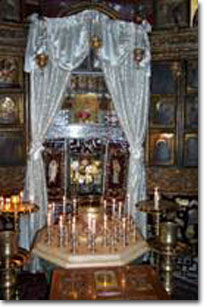 (a New Testament text). (a New Testament text).
The plural Cherubims is sometimes used as a plural, such as in the King James Bible. Orthodox and Catholic Christian theologies include belief in the existence of angels, including Cherubim as the second highest within the angelic hierarchy, below the Seraphim.
They are mentioned in the Bible in the book of Genesis (Gen. 3:24) as the angels who guarded the east side of the Garden of Eden with "a flaming sword which turned every way". - The Convent: It is situated on the highest Eastern tip of Mount Al Qalamoun, 2000 m above sea level. Visitors can reach the monastery via a mountainous paved and winding road, which starts at Boustan Dier Al Sayeda, off the main road between Seidnaya and Maalula. The monastery is 35 km from Damascus and 7 km from Seidnaya.
It was built in the third century A.D, because of oppression against Christians by pagans. It was destroyed in the 16th century, rebuilt in 1982 during the time of Ignatius IV Hazeem, the Patriarch of Antioch and all the Eastern regions, with the help of Mother Catharine Abi Haidar, the Abbess of Our Lady of Seidnaya Patriarchal Monastery.
The convent has two different sections, different in shape and purpose. The first section consists of caves that are graved in the original mountain from the 3rd century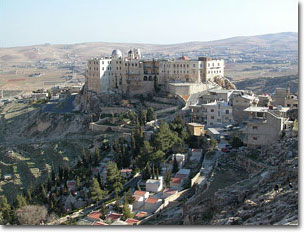 AD. the caves are also grouped into two parts; one that contains shared monastic caves, and one contains solitary caves for each of the monks. Next to all caves is a small stadium for the monks and the reverend father of the monastery. AD. the caves are also grouped into two parts; one that contains shared monastic caves, and one contains solitary caves for each of the monks. Next to all caves is a small stadium for the monks and the reverend father of the monastery.
The second section is a variety of buildings; the reception hall, the monastic residence, the visitors section, souvenirs shop and the old church, which is the oldest part among the buildings. The church contains some of the original frescoes and Early Christian icons.
The Patriarchate has planned and taken action to raise the largest statue of Jesus Christ in the old place of the great cross that was in the highest spot of the monastery territory that overlooks the city of Damascus, al Nabk, Sannin Mountain and Bekaa plain.
Other Monasteries
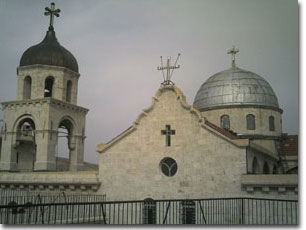 Another chapel is the one dedicated to St. Peter (Mar Boutros), which is converted from an ancient tomb. There are other major sites that are religiously important in Seidnaya; St. Thomas Chapel on Mount Qalamun. Another chapel is the one dedicated to St. Peter (Mar Boutros), which is converted from an ancient tomb. There are other major sites that are religiously important in Seidnaya; St. Thomas Chapel on Mount Qalamun.
The main festival of Seidnaya is the Nativity of the Theotokos on September 8, which draws many pilgrims. The town is flooded with Christians and Muslims alike who gather on the hills and celebrate into the night, dotting the countryside with campfires. |